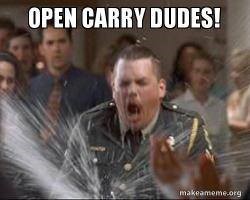Texas Open Carry
*Editor's note: This post was previously posted on my webpage in August of 2016, the year Texas became an open carry state.
There are many critics to open carry laws that have little to no academic study of real world tactical applications. Those of you who have legitimate study in the art of war and do not approve of open carry laws, I humbly acknowledge our disagreement. I submit this article to those who dismiss open carry out of hand without the benefit of studying modern tactical techniques or considering the political strategy surrounding open carry.
Back in January I cautiously exercised my 2A right and Texas' new open carry law because it's awesome.

At the grocery store, no one cared. I was expecting hippies to crawl out of the wood work to shout down my lifestyle choice, but in reality, it was more like this:

And then I thought, that's how it should be. Texas is the embodiment of the 2A. And because we embrace this right, we also embrace that responsibility. It's a big one.

Joking aside, the numbers of murders or even attempted murders by licensed firearm carriers nationwide is microscopically low. (Source: http://www.gunfacts.info/gun-control-myths/concealed-carry/) Open carry is almost 9 months past ratification in the state of Texas and I can’t find any instance of murder or assault as a result of it. If you’d like perspective, firearm homicide is not even close to the number of deaths caused by poor eating habits. (Source: http://www.cdc.gov/nchs/fastats/leading-causes-of-death.htm) Now that we have that off the table, let’s move on to the tactical advantages.
The next argument I’d like to dispel is, “Open Carry is stupid because then the bad guys know you have a gun.” This is a nonstarter for me. I understand the strategic value of keeping certain secrets from an opponent. Choosing to open carry does not fall under the same need for secrecy like masking infantry insertions or hiding unit capabilities. Rather, open carry as a tactic falls under “target hardening.” Target hardening can be something as simple as placing a uniformed guard (even unarmed) to control an entry point. I love the saying, “there are no victims, only volunteers.” In the eyes of a predator, everyone has volunteered as a target and those targets are ranked in order to get the most with the least effort. You, as a potential target, can harden yourself (ie make yourself a less desirable target) in the eyes of a predator just by doing simple things like walking with your shoulders back and head up. You can also wear a firearm on your hip in a holster that balances retention and availability. By doing so, your priority as a target in the eyes of predators has just cratered.
Hand in hand with the above contention is the argument for increased availability of your handgun. Should you have to bring your firearm to bear, your draw time is decreased without the need of rolling up a pant leg or lifting a shirt tail. One aspect of handgun training I teach is “economy of motion.” Performing the most rudimentary motion with the least effort can improve your reaction time. Using fine motor movement or excessive movement decreases response effectiveness.
Lastly, open carry laws provide a politically driven strategy that further secures the Second Amendment. It is no secret that forces within and without our country are ceaseless in their actions to disarm the citizenry. State laws like open carry in Texas or Constitutional carry in West Virginia bolster the individual’s freedom from tyranny by creating a bureaucratic layer between the federal government and the private citizen. I will always be in favor of laws that restrict government action over the actions of the individual.
In closing, I hope you will take this opportunity to broaden your horizons and consider all aspects of open carry laws and decide if it is right for you. I personally do not open carry on a daily basis, mainly because I prefer an IWB (inside the waist band) holster. But I see the value of this law and hope you do too.
Leave a comment below with your opinion and personal preference for carrying.